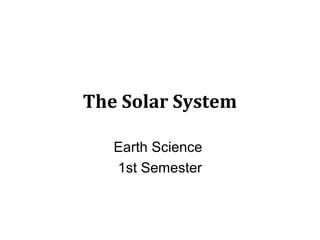
Solar System
- 1. The Solar System Earth Science 1st Semester
- 2. • The sun is the central hub of a rotating wheel of planets, their moons, and many other smaller celestial objects, such as comets and asteroids. • The sun is estimated to contain 99.85% of the mass of our solar system. QuickTime™ and a decompressor are needed to see this picture.
- 3. • The planets traveling outwards from the sun are as follows: Mercury, Venus, Earth, Mars, Jupiter, Saturn, Uranus, and Neptune. • Pluto is no longer considered a planet. QuickTime™ and a decompressor are needed to see this picture.
- 4. • Due to the sun’s gravity, all planets move in an elliptical orbit in the same direction around the sun. • The closer a planet is to the sun, the faster it travels in its orbit. QuickTime™ and a decompressor are needed to see this picture.
- 5. The Planets: An Overview • The planets fall into two groups – the terrestrial planets, and the Jovian planets. QuickTime™ and a decompressor are needed to see this picture.
- 6. • The terrestrial planets include Mercury, Venus, Earth, and Mars. • They are relatively small and rocky. • Since they are closer to the sun they are also known as the inner planets. QuickTime™ and a decompressor are needed to see this picture.
- 7. • The Jovian planets include Jupiter, Saturn, Uranus, and Neptune. • They are huge planets made primarily of gas. • Since they are further from the sun, they are known as outer planets. QuickTime™ and a decompressor are needed to see this picture.
- 8. • Size is the most notable difference between the terrestrial and Jovian planets. • Density, chemical makeup, and the rate of rotation are other ways in which the two groups of planets differ. QuickTime™ and a decompressor are needed to see this picture.
- 9. • The planets have different densities because of their different chemical compositions. QuickTime™ and a decompressor are needed to see this picture.
- 10. The Interiors of the Planets • The substances that make up the planets are divided into three groups based on their melting points. • Gases: Hydrogen and Helium – have melting points near absolute zero (-273 °C or 0 kelvin) • Rocks: made from compounds of silicates and metallic iron, both of which have melting points above 700°C.
- 11. • Ices: Include ices made from compounds of ammonia, methane, carbon dioxide, and water. • These particular ices have intermediate melting points.
- 12. • Terrestrial planets are dense and consist mostly of rocky and metallic substances. • They have very little gas and ice. QuickTime™ and a decompressor are needed to see this picture.
- 13. • The Jovian planets are less dense because they contain: • Large amounts of gases like hydrogen and helium. • Ices made from water, ammonia, and methane. • The outer planets cores contain rocky and metallic materials.
- 14. QuickTime™ and a decompressor are needed to see this picture.
- 15. The Atmospheres of the Planets • A planet’s ability to hold onto an atmosphere depends on its mass and temperature. • Small, relatively warm planetary bodies, with small surface gravity cannot hold much gas. QuickTime™ and a decompressor are needed to see this picture.
- 16. • Therefore, terrestrial planets have very thin atmospheres. • Jovian planets however, have very thick atmospheres composed of hydrogen, helium, methane and ammonia. • They are able to retain thick atmospheres due to their large mass, and low temperatures. QuickTime™ and a decompressor are needed to see this picture.
- 17. Formation of the Solar System – Nebular Theory • Nebula are clouds of dust and gas in space. • These thin, gaseous clouds begin to rotate in space and collapse in upon themselves. • As they continue to contract, they begin to spin faster. QuickTime™ and a decompressor are needed to see this picture.
- 18. • According to the nebular theory, the sun and planets formed from just such a rotating disk of dust and gases. • As the speed of rotation increased, the center of the disk began to flatten out and increase in temperature. • The sun eventually formed in this location. QuickTime™ and a decompressor are needed to see this picture.
- 19. Planetesimals • Planets began to grow as solid bits of matter began to collide and clump together in a process known as accretion. • The colliding matter formed small irregularly shaped bodies known as planetesimals. QuickTime™ and a decompressor are needed to see this picture.
- 20. • As the collisions increased, the planetesimals grew in size, eventually growing large enough to exert a gravitational pull on surrounding objects and pull them in. • In this fashion the planetesimals added more mass and grew into true planets. QuickTime™ and a decompressor are needed to see this picture.
- 21. • In the inner solar system, only metals and rocks with high melting points and high densities could remain. • The sun is too hot for materials with low melting points to stay solid. • The sun does not attract items with low densities towards it. QuickTime™ and a decompressor are needed to see this picture.
- 22. • Materials with low melting points and low densities (like gases) would be forced into the outer solar system due to the sun’s heat and the solar wind. • In the outer solar system, the colder temperatures allowed materials with low melting points to form up as ice. QuickTime™ and a decompressor are needed to see this picture.
- 23. • The Jovian planets were able to form from accumulating solid bits of matter but also from large quantities of ice. • Eventually, the Jovian planets grew so large that they were able to attract even the lightest gases like hydrogen and helium. QuickTime™ and a decompressor are needed to see this picture.